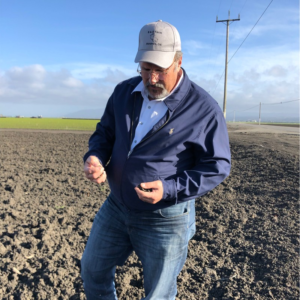Put Biologicals to the Test, Cut Fertilizer Bill with BeCrop

There’s a lot of buzz today about biologicals to boost crop yields, but can they really deliver on their promises? You don’t have to guess anymore, thanks to an advanced soil test that uses genomics to give you answers—and potentially slash your fertilizer bill.
“There’s often a ‘snake oil’ side to biologicals, where the seller says, ‘Just trust me,’” said Al Toops, chief agronomist with BTI Ag LLC. “There’s a better way, thanks to advances in biological soil testing.”
Toops champions the BeCrop® Test, which sequences strains of DNA to determine what microbes are in your soil. Why does this matter? Beneficial microbes, especially mycorrhizal fungi, are essential in releasing valuable nutrients that are locked up in your soil to make them available to your crop.
It’s not enough just to have some beneficial microbes in your soil. They also need to be in balance. “I frequently see soil samples with 25,000 to 35,000 bacteria per gram, and hardly any beneficial fungi,” Toops said. “This is way out of balance, since the ratio in a natural native setting should be 1 to 1 bacteria to fungi.”
It also means that valuable nutrients will remain locked up in the soil, unavailable to plants. “Beneficial fungal species break down carbon residue and move it to the soil,” Toops explained. “This has to happen before the beneficial bacteria in the soil can release the nutrients to the plants.”
When this natural pathway works properly, crops can tap into the goldmine of free nutrients stored in the soil. When the nutrient pathway is blocked, however, it’s a serious loss. Toops has seen cases where soil test show 2,700-7,000 pounds of nitrogen (N) per acre, but only 40-60 pounds of N per acre are available to the crop. “I’ve also seen situations where 500-800 pounds of phosphorus (P) per acre were available, but only 60-120 pounds were available to the crop,” he added.
What blocks nutrient pathways in the soil?
It’s no mystery why these challenges occur, Toops said. Common farming practices, including too much tillage, anhydrous ammonia applications and potash (potassium chloride) applications, destroy many beneficial microorganisms such as mycorrhizal fungi (including vital arbuscular mycorrhizae). These bacteria and fungal species work symbiotically in the soil to keep the nutrient pathways open.
Over-applying nutrients can also block nutrient pathways in the soil. “If you apply N year after year, the organisms that fix N naturally don’t have a job to do anymore, so they go away,” Toops said.
The BeCrop test helps farmers assess what’s going on in their soil at the microbial level so they can start making improvements, without all the guesswork. “BeCrop provides a user-friendly report on soil nutrient cycling, soil health and microbe biodiversity on any field,” Toops said.
But what about those other soil tests?
It’s interesting to note that the BeCrop testing system evolved from the human genomics world, specifically polymerase chain reaction (PCR) testing that emerged in the late 1980s and early 1990s. PCR testing can detect genetic material from a specific organism, such as a bacterium, fungus or virus.
- It’s the latest option in the evolution of soil testing, thanks to BeCrop, to help farmers develop more precise crop production plans tailored to their specific acres. It builds on the previous two generations of soil testing, which are still useful, Toops said.
- The chemical approach to soil testing helps make fertility recommendations. This type of soil testing has been used since the 1970s. It took off in the1990s with grid sampling, said Toops, who added there are 10 million soil tests of this type performed each year.
- There’s a biological approach to testing soil. Rick Haney, a soil chemist/microbiologist with the U.S. Department of Agriculture’s (USDA) Agricultural Research Service (ARS), began exploring this biology-based approach in the 1990s. “Healthy soil is alive,” Toops said. The Haney test determines what quantity of soil nutrients are available to soil microbes and also evaluates soil health indicators such as soil respiration, organic carbon and more.
- The BeCrop soil testing system, which is based on modern genomics research, helps provide an even clearer picture of soil health. It complements grid sampling and the Haney test by providing a data-driven picture of the microbial networks in the soil. “I can look at a genomics test like BeCrop and know what fertilizers have been used in this field, and I can see what’s blocking your nutrient pathways,” Toops said.
BeCrop can provide a lot of valuable information that isn’t measured in other soil tests, Dennis Klockenga, a crops specialist with ProfitProAG. BeCrop measures “biomarkers” associated with enzymes in plant exudates, for example. This can give valuable insights into growth hormones like auxins, gibberellins and cytokynins. “Lots of plant growth hormones can occur naturally in the soil and in plants when the soil is healthy,” Klockenga said. If a plant exudate has low levels of cytokinin, for example, the microorganism associated with that cytokinin phytohormone would measure low in a BeCrop test.
BeCrop also measures plant stress adaptation factors, the soil’s ability to solubilize heavy metals, and more. “When you use the BeCrop test and the Haney test, you get a much more comprehensive picture of your soil health,” Klockenga said.
How BeCrop works
BeCrop gives you a baseline measurement of the biology in your soil now. To use the BeCrop test, Toops recommends creating management zones, which can range from 40 acres to 160 acres. Ten to 12 soil sample cores (no deeper than 8 inches) are pulled throughout each management zone.
“Samples can even be pulled in the winter,” added Toops, who noted that the samples are analyzed at Regen Ag Lab in Pleasanton, Nebraska. “The microbes are dormant, but not dead, this time of year.”
BeCrop offers in-depth insights into soil biology and soil health. “The reports can be a little complex, but we’ll guide you through it,” Klockenga said. The test results are also presented with a color-coded system of yellow and blue to offer an “at-a-glance” view, where blue results are better than yellow results.


As helpful as all these tests are, including BeCrop, data alone isn’t enough. “You need to adopt farming practices that encourage the right balance of beneficial microbes, including the mycorrhizal fungi, so they can work together to make the nutrients in your soil readily available to plants,” Toops said. “This will help your crop utilize these valuable nutrients to grow and thrive.”
Recipe for Success offers simple, practical solution
ProfitProAG makes this easy with a 3-Phase Recipe for Success. “Our Recipe for Success isn’t a cookie-cutter plan,” Klockenga said. “It’s tailored to your acres, whether you raise soybeans, corn, small grains, forages or cover crops.”
- Phase I Residue Management. This “second harvest” focused on efficient breakdown of crop residue to improve soil health and boost nutrient retention/availability, nitrogen fixation, water infiltration, and carbon release to feed the crop during the growing season, while reducing residual insect and disease pressure. The key benefit is improved nutrient cycling from the crop residue, which can help lower your fertilizer bill.
- Phase II At-Plant. Jump start your yield, and get your crop off to a strong start with early-season plant health and vigor. Biological seed coatings and the right starter package supply key nutrients to seedlings and enhance plant health all season-long. “Putting an inoculant in-furrow when you plant is a good way to add more biology,” Toops said. Establishing healthy plants below and above ground is critical to maximizing the crop’s genetic yield potential. ProfitProAG’s seed coatings use biology, rather than chemicals, to help the plant resist crop disease and insect pests.
- Phase III In-Season. Help your crop stay green to the finish for maximum yield potential. This phase helps mitigate plant stress, which is critical when the reproductive phase of yield development begins. Foliar application of nutrients, energy and stress-reducing technology builds resilience and uniformity in a crop-production system. The end result is increased seed numbers, weight and nutrient density in grains. Forages show improved nutrient content, energy, taste, storability and reduced mycotoxins.
Adding biologicals can be part of the Recipe for Success. The microbes in BTI Ag’s biologicals (which are available through ProfitProAG) are encapsulated in protein, which protects them in the soil, Toops said. BTI Ag’s products can also be tank-mixed with crop protection products. “While farmers think of themselves as corn or soybean growers, they are really farming microbes,” Toops said. “If you improve the biology of your soil, the BeCrop test will show it.”
Improvement can happen quickly
Calcium offers a prime example. “For years, farmers have said they can’t get calcium into the crop,” said Toops, who noted that the famed soil scientist William Albrecht also wrote about this phenomenon. “When you make some key changes, however, you can see big improvements in just one year.”
He highlighted a study involving bell pepper production in southern Georgia. When BeCrop testing revealed low calcium levels in the plant, the grower took steps to put biology back in the soil that solubilized calcium and captured the calcium that was unavailable because the nutrient pathway that was blocked was opened. Within one year, BeCrop testing showed that calcium levels improved 25%. “This case isn’t unique,” Toops said. “In just one season, it’s possible to go from very low to low, and keep building from there.”
Putting biology back in the soil is the key to building healthier soil, which leads to healthier plants, animals and people. “The current system of agriculture tends to focus on managing symptoms, rather than preventing these challenges in the first place,” Toops said. “I’m an evangelist for the genomic side of soil testing. This phenomenal tool opens up an exciting new way to better understand how your soil is functioning and help it reach its maximum potential.”
The positive effects go well beyond one growing season, or even a farmer’s entire career. “Your soil is your equity,” Toops said. “Building soil health will build equity now and for generations to come.”
